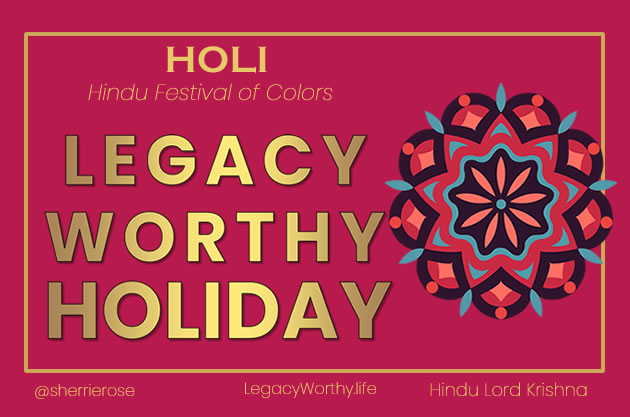The Legacy of Krishna and The Holi Holiday

The Legacy of Krishna and The Holi Holiday
The Legacy of Lord Krishna and Holi are two of the most beloved Hindu traditions. Their legacies have permeated through the centuries, leaving behind a rich and vibrant history that is celebrated every year through the festival of Holi. This festival, which marks the beginning of spring, is a time for joyous celebration and thoughtful reflection on the lives of these two great figures. In this article, we will explore the legacy of Krishna and the Holi holiday in detail, delving into its religious significance as well as its cultural impact.
The story of Krishna is deeply woven into Hindu mythology. He was born to Devaki and Vasudeva in Mathura in 3228 BCE, amidst tremendous adversity and violence inflicted by his uncle Kansa. His life was full of stories that embodied courage, wisdom, love and devotion to God. He is remembered today for his heroic acts as well as his teachings about dharma, or righteous living.
Holi is one of India’s oldest festivals and has been celebrated for centuries in honor of Krishna’s life and teachings. This joyful celebration includes singing traditional songs, dancing to festive music, playing with colored powder called gulal, throwing water balloons at each other and enjoying delicious sweets called gujiyas. It is a time for Hindus around the world to come together in joyous celebration to remember Krishna’s legacy and celebrate life itself!
This year, the Holi Festival is celebrated on Wednesday, March 8, 2023.
1. Historical Origins of The Holiday
Holi is a festival of colors celebrated by Hindus, but it has its roots in the story of Lord Krishna. This holiday has been around for centuries, with references to it appearing in ancient texts. Let’s take a closer look at the historical origins of this special day.
The holiday centers around the legend of Lord Krishna and his beloved Radha. Increasingly popular across India, the festival marks the end of winter and is celebrated for two days in many parts of the country. It begins with a small bonfire on the first night called Holika Dahan or Chhoti Holi. According to Hindu mythology, it commemorates an act of bravery by Lord Vishnu against Holika, who had been given immunity from fire by her brother as a reward for her devotion.
On the second day, people gather together to enjoy each other’s company and splash each other with colored powder and water balloons. The revelry serves as an expression of joy and a reminder that good will always win over evil forces. While people celebrate in different ways, they are all united under one theme: love conquers all.
Today, Holi is celebrated not only in India but across many countries worldwide – demonstrating how meaningful traditions can travel far beyond their original context while still remaining true to themselves.
2. Spiritual Significance of The Holiday
Holi, the Hindu spring festival of colors, is celebrated with great enthusiasm around the world. It is known to be a joyous celebration of love, but its spiritual significance runs deeper than that. On this day, Hindus remember and celebrate the divine love of Lord Krishna and Radha.
Krishna is said to have brought happiness into people’s lives through his playful pranks and mischievous behavior. He is seen as an avatar of Vishnu, the preserver in Hinduism’s triumvirate of gods. On Holi, Hindus honor him by lighting bonfires and playing with vibrant colors. The throwing of colored powder symbolizes how Krishna used to colorfully paint Radha’s face when they were together. By celebrating their love story on Holi, Hindus remind themselves that devotion and true love are the most important things in life.
Moreover, at the heart of Holi lies a reminder to let go of our egos and any past grievances we may be holding onto—just like Radha did for her beloved Krishna when she forgave him for his wrongdoings. This also serves as a powerful example that anyone can reach enlightenment if they learn to accept others fully despite their flaws or mistakes. Thus, Holi stands out as not only a time for revelry but also for reflection on what it means to truly devote oneself to someone else or something greater than ourselves.
3. Who Was Lord Krishna?
Lord Krishna is a revered figure in Hinduism, and his legacy has been celebrated for centuries through the holiday of Holi. He was a divine prince who lived during the era of the Mahabharata, an ancient Sanskrit epic about a conflict between two branches of a royal family. Krishna is believed to be an avatar or incarnation of Vishnu, one of the principal gods in Hinduism.
Krishna’s life story is depicted in various texts like the Bhagavad Gita, which explains his teachings on spiritual enlightenment. It also covers his many adventures as he led his people against injustice and evil. Many Hindus view Krishna as having set an example of righteousness and justice that they should strive to emulate.
Krishna’s legacy is celebrated every year when millions gather to celebrate Holi, throwing colors around and sharing sweets with friends and family. It’s seen as a time for joy and renewal, and it honors both Krishna’s divinity and humanity – highlighting how even those with great power can use it for good deeds. Holi serves as a reminder to follow in the footsteps of Lord Krishna by remaining true to oneself while helping others overcome darkness and lead lives filled with love and light.
4. How Holi Is Celebrated In India And Other Parts of The World
Holi is an ancient Hindu religious festival that celebrates the divine love of Krishna and Radha. It’s also known as the Festival of Colors due to the vibrant colors associated with it. Across India, and in other parts of the world where there are large Hindu populations, Holi is celebrated with great enthusiasm and joy.
The traditions surrounding Holi vary, but usually involve powdering each other with brightly-colored powders or spraying one another with water guns filled with colored water. People also gather around a bonfire in celebration, which symbolizes new beginnings and purification. Additionally, many Hindus observe fasts on this day and sing devotional songs to honor Lord Krishna.
Holi has become an international phenomenon in recent years. People from all walks of life come together to take part in this colorful event, regardless of their faith or nationality. It’s a beautiful reminder that we’re all connected by our humanity; a time when we can put aside our differences and enjoy the richness of life together. No matter where you celebrate it, Holi is sure to bring happiness and joy into your life!
5. Legacy and The Types of Holi Events
The legacy of Krishna and the Holi holiday have been celebrated by Hindus for centuries. In India, the celebration starts with a bonfire on the eve of Holi signifying the victory of good over evil. People come together to pray for prosperity and share sweets with each other.
On the day of Holi, people throw colors and water at each other in joyous abandon. It’s a time when anyone regardless of their status or background can join in and have fun. This tradition has spread across many parts of the world, allowing non-Hindus to experience this vibrant festival as well.
There are several types of events associated with Holi such as traditional rituals like singing devotional songs and performing religious dances, as well as more modern activities like playing music, participating in color runs, and even organizing parades. All these activities help to keep the spirit of Holi alive and foster a sense of communal unity among participants. By celebrating this joyous festival, we remember our beloved Lord Krishna and celebrate his teachings which continue to inspire us all today.
6. Legacy of Music and Dance In Holi Festivities
Holi festivals are celebrated with great enthusiasm all over India, and certain aspects of its cultural heritage remain as integral parts of the event. Music and dance have always been essential components of these celebrations. The legacy of Krishna, who was known for his love of music and dance, is still honored in these festivities.
Music plays a major role in Holi events, from the chanting of traditional songs to the performance of classical Indian ragas. It is believed that such music helps to create an atmosphere where people can relax and feel connected to each other. Similarly, dancing has always been a part of Holi traditions, with various forms being practiced by participants. In most places, folk dances are performed to honor the gods or commemorate special occasions.
The joyous singing and dancing create a unique atmosphere that allows people to escape their daily lives and come together as one community. Even in modern times, many holi celebrations around India feature traditional music and dance performances that honor the cultural legacy passed down through generations. This helps keep the spirit alive while allowing us to appreciate our heritage in new ways.
7. Traditional Foods of Holi
Holi is celebrated with a variety of traditional foods and snacks. From tasty sweet treats to savory dishes, these foods are an important part of the festivities. Different regions have their own specialties to enjoy during Holi, making it a truly unique and diverse celebration.
One popular food served during Holi is gujiya, deep-fried pastry pockets filled with a mix of dried fruits, nuts, and spices. Gujiya is usually made in large batches so that there’s enough to share with family and friends who are celebrating together. Another dish commonly enjoyed during Holi is puran poli, a flatbread stuffed with sweet lentil filling. This is often served alongside savory curries or dals for a complete meal.
To round off the feast, desserts like gulab jamun (milk-based balls soaked in honey syrup) or rasgulla (cheese balls in sweet syrup) are also popular choices for Holi celebrations. These sugary treats provide a nice balance after all the savory dishes that have been served throughout the day. All of these tasty traditional foods make Holi extra special and memorable for everyone who celebrates it!
8. Rituals and Customs of Holi
Holi is an ancient Hindu holiday that celebrates the victory of good over evil and the arrival of spring. It’s a time for spiritual reflection, feasting, and most of all: fun! Rituals and customs are an important part of Holi celebrations, as they help to reinforce the holiday’s traditional values.
One common ritual is the burning of an effigy known as “Holika.” The burning symbolizes the destruction of evil and is often accompanied by prayers for health, wealth, and happiness. Another ritual involves playing with colored powder called gulal. The colors are thought to bring joy and signify friendship, love, unity, and freedom from social conventions.
The final ritual of Holi is a feast shared among family and friends. Filled with traditional dishes like gujiya (a sweet pastry treat), mathri (a savory cookie-like snack), chaat (savory snacks) and more, it’s a time to enjoy delicious treats together while reflecting on the legacy of Lord Krishna. As we come together to celebrate Holi each year, these rituals remain an integral part of our traditions.
9. Legacy of Colorful Symbols of Holi
The Holi festival is a time of joy and celebration, full of color and vibrant hues. But what lies beneath this colorful holiday is the legacy of Krishna, the Hindu god known for his playfulness, love and protection. As such, many of the symbols associated with Holi have a deeper spiritual significance.
Holi celebrates the triumph of good over evil, which has been represented in its most recognizable symbol: colored powder. Throwing and smearing colored powder on each other is a way of paying homage to Lord Krishna’s playful nature while also serving as a reminder that good will always prevail. Additionally, water is symbolic of renewal and purification, so sprinkling or spraying water adds an extra layer of meaning to the festival.
The practice of lighting bonfires during Holi signifies burning away all negativity gathered over the year and starting anew with optimism and hope for the future. The gathering around these fires also serves as a reminder to come together as one community to celebrate life’s joys and triumphs over adversity. Such traditions make Holi an important cultural event filled with lasting symbols that continue to shape its legacy through generations.
10. Legacy of Hindu Mythology and Holi
Holi is a Hindu festival that has been celebrated for centuries. It marks the end of winter and the arrival of spring, and symbolizes renewal, joy, and hope. The holiday is rooted in Hindu mythology, and the stories behind it have become part of India’s cultural heritage. From Lord Krishna’s mischievous pranks to the burning of Holika Dahan, these stories have a lasting legacy that continues to be celebrated today.
The most popular story associated with Holi involves Lord Krishna’s mischievous behavior as a child. He would often steal butter from his neighbors and smear it on his face and body while playing with other cow-herd boys. To hide his dark complexion from the gopis (female devotees), he would color their faces with vibrant colors. This playful spirit has been passed down through generations, inspiring people to celebrate Holi by smearing each other with powder or liquid colors known as gulal.
Today, Hindus around the world commemorate this festival by celebrating with family, friends, and neighbors. But even those who live abroad can join in the festivities by using natural ingredients like turmeric or sandalwood powder to make their own colors at home or joining online gatherings for virtual celebrations. While modern life may keep us apart in some ways, Holi helps us to connect with our heritage and pass down its legacy to future generations – no matter where we are in the world.
12. How To Celebrate Holi Abroad
Holi is an important Hindu holiday that celebrates the victory of good over evil and commemorates the legacy of Krishna. It’s a time of joy, laughter, and most importantly, lots of color! While it’s traditionally celebrated with friends and family in India, it’s possible to enjoy Holi abroad with some careful planning. Here’s how.
First, research any local celebrations or gatherings taking place in your area. Many Hindu temples have public celebrations for the holiday that you can join in on. If there are no public events, try to get together with other Hindus living in your vicinity and celebrate together! Make sure that everyone is aware of any local laws or regulations regarding color play before starting.
Finally, if you want to bring the festivities home with you to share with friends and family who don’t live nearby, you can order traditional Holi supplies online. There are plenty of websites offering colorful powders (gulal) and sprays (pichkari), as well as sweets like gujiya and mathri. Alternatively, you could make your own natural gulal by grinding dried petals! With these tips, you’re now ready to enjoy Holi wherever life takes you.
13. Holi In Popular Culture
Holi, the Hindu festival of colors, is celebrated in many countries around the world. It has become popularized in modern culture, often appearing in media such as movies and television shows. The holiday celebrates the love between Krishna and Radha, but has grown far beyond its religious roots.
In recent times, Holi has become a representation of joy and a celebration of life. Movies such as ‘Dilwale Dulhania Le Jayenge’ have featured scenes of Holi festivities while TV series like ‘Sacred Games’ have included it as an important part of their plotlines. These portrayals are often used to emphasize themes such as family values and friendship.
The vibrant colors associated with Holi have also been used for art projects and fashion shows, further showcasing how this holiday has made its way into popular culture. The legacy of Hindu mythology and Holi will continue to be seen in modern culture for years to come.
The holiday’s inclusion in media gives people from all walks of life an opportunity to explore the beauty of Indian culture and tradition without having to experience it firsthand. This allows them to gain a deeper appreciation for the rich history behind Holi and its significance in Hindu mythology.
14. Environmental Impact of Holi Holiday
The environmental impact of the Holi holiday comes with considerable consequences. Every year, millions of people take part in a colorful celebration of love and devotion, but this has serious implications on the environment. Pollution levels are higher than usual due to the use of artificial colors and fireworks, which can have long-term effects on both human health and the local ecosystem.
The use of artificial color powders is one of the primary sources of pollution during Holi celebrations. These powders contain ingredients such as tin oxide, chromium, lead oxide, carbon black, and aluminum which are all harmful to humans if breathed in or ingested. Additionally, these chemicals are washed off into nearby rivers and lakes when it rains after the festival has ended, contaminating water sources for months afterwards.
Fireworks also play a part in polluting the air during Holi celebrations. Not only can they cause damage to buildings or even start fires, but their smoke contains hazardous particles that can cause respiratory problems for people living nearby. Even sparklers used as decorations release large amounts of smoke into the atmosphere that can last for days after the festivities end.
Clearly then, there are many environmental repercussions associated with celebrating Holi that should be taken into consideration before taking part in this tradition. There are ways to minimize its impact by using natural dyes or avoiding fireworks altogether; however, it is up to everyone to make sure we keep our planet healthy while still enjoying this beloved holiday.
15. Holi Celebration Safety Tips
As the Holi holiday approaches, it’s important to keep safety in mind. Celebrating the religious festival of colors and love should be done with caution. This article will provide a few tips on how to have a fun and safe Holi celebration.
When playing with colors, make sure you’re using food-grade dyes or natural plant-based pigments. These won’t irritate the skin like synthetic dyes can and are safer for people as well as the environment. Choose bright, bold colors that are vibrant yet still safe for your eyes. It’s also important to avoid any form of physical contact while celebrating; throwing water or powder at someone could lead to serious injury, so keep distance from one another in order to enjoy the festivities without any harm.
Finally, after the celebration is over it’s essential to clean up properly and discard all materials responsibly. Throw away paper bags and wrappers in designated bins and ensure that no dye seeps into nearby rivers or lakes. Doing this will help preserve the legacy of Krishna and prevent any damage to our ecosystem. With these safety tips in mind, everyone can safely enjoy a memorable Holi holiday!
16. Holi Gifts and Souvenirs
Holi gifts and souvenirs are a great way to remember this joyous Hindu festival. It’s the perfect time to give something special to friends and family. Whether you’re looking for something traditional or modern, there are plenty of options available that celebrate the legacy of Krishna and the Holi holiday.
One popular gift is a Holi-themed scarf with colors representing love, peace, and harmony. Another option is a festive t-shirt with a message of appreciation for the Festival of Colors. You can also find mugs, art prints, jewelry, keychains, stickers and other items that can be used as reminders of this treasured celebration.
When it comes to souvenirs, there are many things to choose from including small statues of Lord Krishna or Ganesha, diyas (small oil lamps), incense sticks in various scents, colorful bangles, vibrant saris and other items associated with the holiday season. Whatever kind of keepsake you choose will surely bring back fond memories for years to come.
No matter what kind of gift or souvenir you decide on for Holi, it’s sure to be appreciated by those who receive it. So why not make this joyous occasion even more special by giving something meaningful?

Holi is one of the most beloved and vibrant festivals in India, celebrated with great enthusiasm by people of all ages. The festival is steeped in tradition and celebrates the life and legacy of Lord Krishna. Throughout India, it is celebrated by people singing, dancing, throwing colored powders at each other, and having bonfires. Holi has also become popular around the world as an opportunity to come together for a day of fun, celebration, and joy. Though it is an event that many look forward to each year, it is important to remember the environmental impact that this holiday can have. Taking steps like using natural dyes instead of chemical-based ones can help reduce its harmful effect on Mother Nature. By understanding the spiritual significance behind Holi, celebrating responsibly and safely, and bringing friends and family together to share in its joys, we can honor the legacy of Lord Krishna for generations to come.



